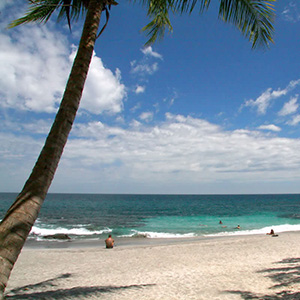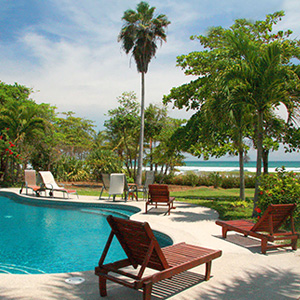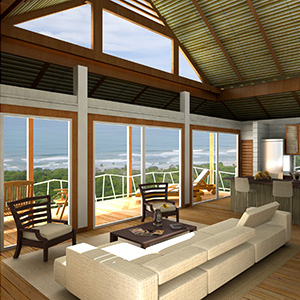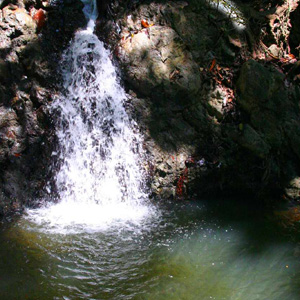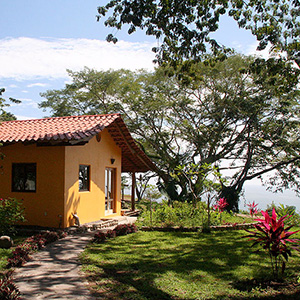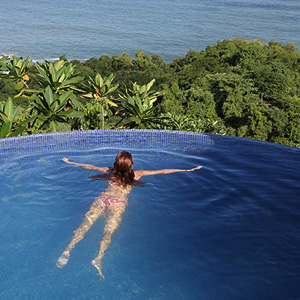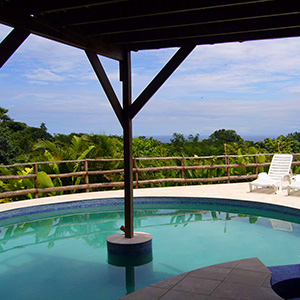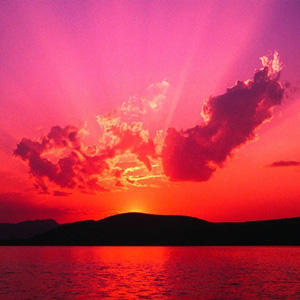Green Building in Costa Rica
© Copyright 2010 by Geoffrey McCabe – Google+
Email: geoff@tropisphere.com
Phone: (011-506) 8844-4726
Primary Considerations
1. Cooling Considerations
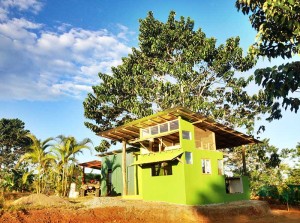
Rather than using a clothes dryer, consider building a sunroom like Jakob Bjerre did in his solar-powered house in Montezuma. Even on cloudy days, this sun-room is hot and dry, and rapidly dries clothes hanging on a line. His brilliant design also located the sun-room next to the solar power equipment and batteries, which used this extra heat generated by the system to heat the drying room.
2. Septic/Blackwater treatment
You can do your own sewage treatment. Montezuma’s Hotel Sano Banano has a $10,000 system that services their restaurant and 12-room hotel and they claim it could also serve several more businesses around them. It’s imported from Italy, and they claim that the water that comes out the other side is drinkable (not that they drink it.) Also, there are septic systems far superior to the cheap ones that are usually installed in our area. They cost a little bit more, but they’re worth it. Adding a liquid bacteria called “EM”, available at the local Cooperativa, in Cóbano aids in the process. Never use chlorine-based cleaners to clean toilets, because this toxic chemical kills the bacteria that are processing the blackwater waste in your septic system.
Instead, use natural cleaners from Bioland, lemon-based cleaners, or vinegar. Hotel Aurora in Montezuma is doing this now and their septic system runs perfectly without any smells or seepage of toxins. Another option is to use an incinerating toilet, which turns blackwater waste into ashes, and has the side benefit of destroying any pharmaceutical chemicals that have passed through your body. These chemicals have been shown to have potentially harmful effects on wildlife in rivers and streams as they build up in the environment.
Incinerating toilets are expensive ($2000-$3000 for electric or gas models), but they save money on water bills, and if you use them exclusively, you won’t need to build and maintain a septic system at all.
3. Water Catchment
Possibly the most important ecological consideration in the Malpais/Montezuma area of Costa Rica. A house can be designed to channel water from its roof and deck spaces into an underground storage tank, for use during the dry season. A tank can be designed so that it’s built into a hillside, and the top becomes a grassy patio. It can also be designed so that it’s next to your house, effectively becoming a “heat sink” to absorb the day’s heat into the water, keeping your home cool. Water cachement is your best insurance policy against a water crisis that may result from un-managed development, and is much cheaper than drilling a well. In many areas of the world, such as some places in the Caribbean, water catchment is considered the norm, and it should be in the dry forest areas of Costa Rica also. A tank can be built out of cement like a swimming
pool, or large plastic tanks can be used. Visit the website Agua Solutions for more info. This company is in Liberia, Guanacaste province, and provides rainwater catchment solutions. How much rainwater can be captured by a roof? If it rains 100 inches per year, then a 200m2 home can catch around 100,000 gallons.
4. Dogs/Cats
Dogs are probably the worst destroyer of the local ecosystem. Normally, the area would have one family of coyotes for a thousand hectares or so. With hundreds of dogs introduced to the area, wild animals start avoiding these places and biological corridors stop being used, leading to inbreeding and eventual extinction. Large dogs kill many ground animals such as pizotes, foxes, anteaters, and even porcupines – sometimes dying themselves in the process. Dogs can be trained not to attack or threaten wildlife, but few owners have the skill, patience, or awareness to do so. “Man’s best friend” has no place in the jungle.
5. Location
Much of the environmental benefit of trying to live a greener lifestyle is negated if the location is far from services, entertainment, and community. If one does not have to drive a long distance to buy groceries, go to the beach, or visit friends, then more energy will be saved. Such a lifestyle can be more rewarding as well. Thus the ideal location for a “green” house or development is close to town and the beach.
6. Reforestation
Except for in the deepest, steepest river valleys, most of the jungle in the area had been logged out many decades ago, and the jungle that has grown back has been mostly common softwood trees that are easily spread by birds and bats. Consider planting native hardwood trees that are nearly extinct in the area. Seedlings should be planted near to the beginning of rainy season so their root systems will grow strong enough to keep the plants alive through their first dry season. These trees can be obtained for 500 colones ($1) at Rainsong Wildlife Sanctuary in Cabuya. Visit their website Rainsong Wildlife Sanctuary to see a list of recommended native tree species. Please order your trees in advance so they have time to obtain them for you.
7. Xerascaping
This is a simple landscaping concept that involves breaking your land into three zones. The first, and smallest, is an area for plants that need daily watering – usually near the house. The second, medium-sized zone, uses drought-tolerant plants that need only occasional watering, perhaps once a week during the dry season. The largest zone contains only native plants that never need to be watered.
8. Construction Materials
One major consideration in sustainable development is using local materials. While Teak and Melina trees are not native species and both are usually grown as a monoculture, in many ways they are good options. They are grown in large quantities locally, and generally no pesticides or toxic chemicals are needed to preserve them from wood-eating insects.
Cement isn’t produced locally, but it’s made in Costa Rica and is considered a non-toxic building material. Cement is a better option than wood because it lasts longer, requires much less maintenance, and has fewer spaces for bugs to live in. Living in the tropics, you will have many 6 and 8 legged “friends” in your house regardless of the materials you use, but with cement, you’ll have fewer and can keep the bugs under control more easily without spraying poisons.
Stucco – a good option for covering your walls is non-toxic stucco. As far as I know, there’s only one chemical-free brand available in Costa Rica, Manos Magicas. For inside walls, consider using stucco that is shiny polished. This lasts much longer than paint and is much more easily cleaned. Low-maintenance construction is “greener”.
9. Spend Locally
A big part of green building is thinking about the effects on the community. Whenever possible, use materials that are not only produced locally, which reduces the energy needs of transporting them, but keeps the money spent in circulation in your area. Whenever possible, use subcontractors that are as local as possible. Spending locally reduces poverty and benefits everyone. For example, instead of buying towel racks from San Jose that are made in China, hire a local blacksmith to make them.
Secondary Considerations
1. Appearance
Use green and brown stuccos for coloring, and natural wood, or metal painted to look like wood, creating an almost invisible set of buildings that blends into the jungle and looks very luxurious and high-end as a result. A good example of this is how the Florsheims did their “Latitude-10” luxury beachfront bungalows in Santa Teresa. Choose building shapes that create natural shadows and aren’t just big rectangles with flat sides.
2. Grey water treatment
You can use a series of rocks, gravel, and sand ponds that can be part of the landscaping to clean the greywater. This water comes from showers, sinks, and kitchen, and the food particles and other organic material in the greywater can be beneficial to the environment if treated properly. Chemical and chlorine-based cleaners shouldn’t be used for cleaning since these chemicals will go straight into the soil.
3. Solar Power
May be a waste of money and overall isn’t particularly good for the environment. The process of creating solar cells is very toxic, and it requires huge banks of lead batteries that have to be periodically changed and maintained. By using solar, you are essentially cleaning up your local area while polluting somewhere else. I’ve found that even a large expensive system sometimes won’t power a clothes dryer or even a hair dryer. However, tens of billions of dollars is being poured into solar cell research right now by startup companies in Silicon Valley, and in a few years, we may see more efficient solar systems that are made by more environmentally
friendly manufacturing processes. If you love solar and want to support the movement to encourage the technology, consider also a solar-assisted energy solution – your solar cells run without battery storage – they’re on during the day to help power the refrigerator and a few essentials, and at night you run power from the lines. This saves you money and doesn’t require all the lead batteries.
In addition, a new type of solar panel from a startup company called Soliant has been recently invented which is promised to be half the price of the best panels today. This amazing invention is supposed to be ready for residential use in 2008. For more information, click: Cheap Solar Panels. Within a couple more years, the company promises an improved model at 1/4 the cost. This makes the use of solar cheaper than regular electricity, and should be a huge benefit to the environment. Using these still requires the lead batteries, but these systems utilize far fewer of the solar cells themselves by reflecting more light onto them. This reduces the toxins created in the solar cell production.
Two good Alternative Energy Solutions to solar power can be obtained in Costa Rica: Windmills and micro-hydro. Micro-hydro will work if you have a small stream running on your property, and has the benefit of providing power 24 hours a day, rain or shine. It’s cheaper and much less toxic than solar power, and if necessary, can be stored in battery banks like solar. Such systems need to be built into a very strong cement/stone box at the bottom of a nearby canyon, because they could be easily stolen.
4. Lakes and Ponds
Build ponds or a small lake bordered by water plants and floating water hyacinth (which has beautiful pink flowers and prevents mosquitoes), stocked with tilapia fish. A lake will bring water birds such as white ibis and roseate spoonbill, jungle animals, and a cooling effect due to evaporation. Lakes can also help maintain the underground water table. Rain cachement systems can be set up to take water from the roofs of the buildings and run them into the lake, so they don’t have to be filled by well water. Ideally, lakes should be built where a natural spring will keep them filled during the dry season. As an alternative, consider a seasonal lake that fills during the rainy season, and slowly evaporates during the dry season. The bottom can be lined with local red clay to help prevent seepage, or partially covered with plastic sheeting.
5. Ylang Ylang Trees
Plant many Ylang Ylang trees, which stay green and flower all year, and have an amazing scent every day at dusk. They also have fruit all year. Having Ylang Ylang trees is like putting out feeders for birds and animals. They will become a destination spot for many rarely seen animals such as Kinkajous, four-eyed tree opossums, parrots, and toucans. Of course the Monkeys and other common species love them too. There is no better tree than Ylang Ylang for this area.
6. Refrigeration
Consider buying a Sun Frost or Sundanzer brand refrigerator. These amazing units are far more efficient than normal refrigerators. The Sundanzer is equivalent to a single 60 watt light bulb! Sunfrost or Sundanzer.
7. Lighting
Outside lights should be shielded and oriented in such a way so the bulbs can’t be seen directly, which would otherwise create an eyesore at night and attract bugs. Insects are part of the ecosystem and too much light pollution could have a bad effect on their population. Bugs are annoying in your house, but they are food for many of the other animals in the jungle, and also moths are very important for controlling vines. 70% of moth species have evolved their life-cycle around a single species of jungle vine, and they eat it and lay their eggs on it. Consider using compact fluorescent lighting, which saves money on bulbs because of their long life, and uses far less power. You can buy bulk packs of various sizes of these bulbs at Pricemart in San Jose. Most importantly, design your house so that less lighting is required, especially during the day. Adding skylights and clerestory windows, and using light colored ceilings, walls, and floors to reflect ambient light will make it so that you need few or no lights during daylight hours.
8. Butterfly/hummingbirds
Planting the right type of flowering bushes will not only look beautiful, but will bring many butterflies and hummingbirds to the project. Having an in-ground butterfly garden is a good selling point. Having a lot of butterflies also brings more birds who eat the butterflies.
9. Herbs/gardens/orchards
Consider planting an herb/vegetable garden as part of the project, incorporated into the landscaping. Plants that grow very well here are basil, cilantro, chili peppers, and cherry tomatoes. Perhaps add some fruit trees – avocado, mango, lemon, lime, etc Some types of garden veggies, such as lettuces and spinach, will grow well here, but are devastated by grasshoppers and iguanas. You can keep away these pests by creating a greenhouse with walls and ceiling made from screen, and putting some plants above ground on tables. I’ve seen this working well even in the Osa peninsula. The screen also reduces the amount of sunlight, so the plants don’t get burned by the intense tropical sun.
10. Electric Wires
Too many monkeys and kinkajous have been fried on wires and transformers recently. Wiring should ideally be below ground, but this is very expensive and if you can’t afford it, then above-ground wiring should have the TOP (hot) wire shielded with a rubber covering, and the transformer leads should be shielded with foam. This adds extra cost, but not much in the grand scheme of planning a whole development.
11. Nature Trails
Even with all the wild jungle-covered places in the area, there are few places to go hiking. Developers in the U.S. have found that having trails for walking, jogging, or mountain-bike riding are the #1 amenity requested by potential homeowners. Consider building trails that are also suitable for night-hikes, so that people who want to see wild animals can look for them at night with flashlights, when they’re most likely to be spotted.
12. Views
Everyone wants breathtaking ocean, mountain, and valley views, but sometimes trees are blocking these vistas. Instead of removing trees, you can cut them shorter, effectively “banzaii-ing” them – keep them trimmed short and they will grow horizontally. An even better option is to only cut the lower branches off, leaving a high canopy that provides shade. Both options leave the trees’ root systems intact, which hold in the soil and prevent erosion from the hillside.
13. Green Shading
Consider using clever and innovative techniques to shade your house, both roof and walls, using plants. One concept is to put a metal grid next to the wall and let vines climb on it. Planting vines such as passion-fruit will give you beautiful flowers and organic fruit to eat. Such a grid can be mounted over the roof as well, and these can be incorporated into the design. Another option is to build a flat roof with a geodesic-dome type structure on top, creating a ceiling of plants and a shady green space underneath. Such structures are also fun because you can easily hang lights and décor from them, creating a very magical rooftop space.
14. Soil Maintenance
Erosion, mulching, chemical free. Steps should be taken to prevent erosion of the soil on the property but making sure there’s a good living ground cover, or a mulch to keep the soil from washing away from heavy rains. A good groundcover is mani (peanut) grass, which also has pretty yellow flowers. Its root system holds tightly onto the soil, and is especially useful in steep areas. Mani grass is available everywhere and can be obtained for free
15. Construction Site
A well-organized construction site will reduce waste. Burning leftover wood releases large amounts of CO2 into the atmosphere, so waste wood that can’t be used for anything can be buried, or left in a pile to decompose naturally. Sawdust can be used as mulch in the garden.
Green Building and Real Estate Links:
Forbes Magazine: Inside an Eco-Mansion – Photos and details of green homes built for the wealthy
Green Building Innovation – Tropical Designs – Three tropical green building concept houses
Green Building Design and Product Sources – Greenbuilder.com’s extensive sourcebook of sustainable building supplies and ideas
Green/Eco Developments:
Costaricaecolodges.net – Sustainable tourism, green hotels, eco-lodges, etc
RanchoDelicioso.com – Montezuma/Santa Teresa Eco Village
Solar-Vistas.com – Santa Teresa / Malpais ecological community
PuraVidaSunsets.com – Pura Vida Sunsets Sustainable community located in Montezuma, Costa Rica
RanchoMastata.coml – 550+ Acre Sustainable Living and Environmental Learning Center focusing on the Tropics of Costa Rica
The Eco-Village – Sustainable development, 7km from one of the best beaches on the Gold Coast of Australia
Sonoma Mountain Village – Huge Green-built eco community being developed in California
Solar Village – Colorado Based Green Developer and Consultant
Green Real Estate and Investment News:
Costa Rica announces goal to be the world’s first ‘Carbon Neutral’ country – by 2030 – TreeHugger.com Artile on Costa Rica’s leadership in Going Green (May 28, 2007)
The Green Real Estate Boom – MSN Money Article on the Green Real Estate Market in the U.S. (June 1, 2007)
Citigroup Investing in Green – Citigroup Pledges $50 Billion in
Investments to Fight Climate Change
Big Solar’s Day in the Sun – CNN.com article on how large-scale
solar power plants are going mainstream worldwide (June 5, 2007)
